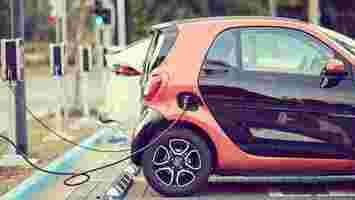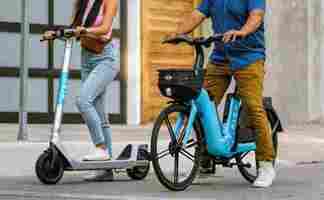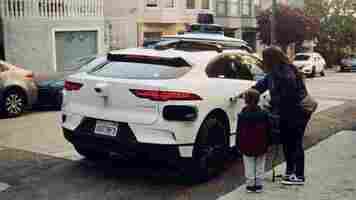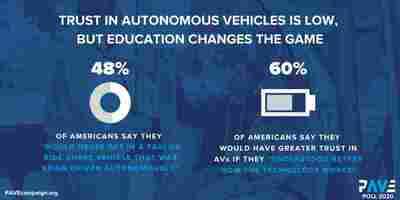Case study: How to make your city EV friendly
This article was originally published on Cities Today , the leading news platform on urban mobility and innovation, reaching an international audience of city leaders. For the latest updates follow Cities Today on Twitter , Facebook , LinkedIn , Instagram , and YouTube , or sign up for Cities Today News.

With electric vehicle (EV) sales booming across the US in recent years, cities must keep pace and begin actively planning their city’s electric vehicle infrastructure, ensuring residents and businesses are able to easily electrify.
The number of EVs on US roads is projected to reach 18.7 million by 2030, up from 1 million at the end of 2018. States including California and Massachusetts have already committed to phasing out sales of new internal combustion engine (ICE) vehicles by 2035, and more are expected to follow. Automakers have taken heed of changes and are increasingly diversifying vehicle output towards electric. Cities of every size must now prepare.
“While the big cities get most of the press for their electrification initiatives, smaller cities can actually adapt and futureproof more quickly in ways that are equitable and community-focused,” said Oliver Adrian, Head of Consulting at eMobility firm Hubject . “That quick adaptability has real impact and is the real engine of national change.”
The task can seem daunting due to the number of factors that need to be taken into account, such as prioritizing actions, balancing a short and long-term view, identifying gaps in EV infrastructure and opportunities where it can be deployed most effectively, ensuring financial sustainability, and getting the right stakeholders around the table.
The process doesn’t have to be time-consuming or expensive, though, as pioneering cities are showing by working with expert partners who understand the charging landscape and who are connected to key players.
This can be the most effective way to develop a tailored, comprehensive plan that is built for quick deployment, geographic equity, and growth opportunities.
Charging ahead
Peachtree Corners in Georgia, for instance, is already underway with a comprehensive EV infrastructure strategy which it developed with Hubject.
The city recently opened a new EV fast-charging plaza which can fast-charge up to 16 vehicles simultaneously. The deployment is the first measure from the city’s new electrification plan.
Hubject’s analysis identified that Peachtree Corners was essentially “an EV fast-charging desert,” particularly considering the growing electric vehicle ownership in and around the city. The company analyzed the city’s residential, business, and retail layout, as well as traffic patterns and electrical capacity to identify the ideal location for the charging plaza, which is situated at Peachtree Corners town center.
Twelve Tesla V3 superchargers are now operational at the plaza as well as four universal charging stations. Two 350 kW chargers, and two 150 kW chargers, will go live this month, making the plaza capable of charging all types of EV models. It will be one of the largest public charging facilities in the state of Georgia and the largest in the Metropolitan Atlanta area.
“More than 55,000 vehicles a day will pass by the new charging hub via the main corridor, reflecting our initiative’s immense impact on the larger region, in addition to Peachtree Corners residents,” said Brian Johnson, City Manager of Peachtree Corners. “Not only is this a significant economic driver for our city, attracting retail and other related activities, but it’s also serving as a model for other communities across the nation to follow as electrification continues to expand.”
Business models
Getting the right business models in place is a key area where expert input can be beneficial, including negotiating, contracting, and publicity. In Peachtree Corners, for instance, the chargers were funded by the charging network providers, who recognized the value of the site to their customers.
“ Working with Hubject allowed us to accelerate our EV charging deployment efforts without exceeding our budget,” Johnson said. “The Hubject team identified our needs and connected us with key players, which resulted in the quick development of an Electrify America charging station and the largest Tesla Supercharging station in the Atlanta metro area. ”
The partnership between Hubject and Peachtree Corners is set to continue into 2021 and activities will include additional grant-funded electrification projects and other EV charging efforts.
Expert partnerships can also help cities navigate issues such as designing incentive programs, city fleet EV conversion, utility preparation, and more.
“The Hubject team has developed a great approach to help smaller cities plan for the electrified future,” said Peachtree Corners Commissioner Tim Echols, who serves as vice-chair of the Georgia Public Service Commission. “As an EV driver myself, I hope more Georgia communities adopt similar initiatives to Peachtree Corners so as to make their community more attractive for electric vehicles.”
SHIFT is brought to you by Polestar. It’s time to accelerate the shift to sustainable mobility. That is why Polestar combines electric driving with cutting-edge design and thrilling performance. Find out how .
Bird opens its app to local bikesharing operators in 5 cities — for free
Did you know SHIFT is taking the stage on Sept 30 and Oct 1 ? Together with an amazing line-up of experts, we will explore the future of mobility during TNW Conference 2021. Secure your ticket now !

In June, Bird expanded its micromobility services by adding to its escooters a fleet of shared ebikes . The company launched its first dedicated Bird Bike along with the “Smart Bikeshare Program” that allows local shared ebike and emoped providers to integrate with the Bird app.
At the time, Bird had only partnered up with the Italian emoped operator ZigZag , but as of Wednesday the company has rolled out f ree public bikeshare integration with multiple cities.


Local bikeshare service providers in Oslo ( Oslo City Bike ), Austin ( Metrobike Austin ), Los Angeles ( Metro Bike ), San Antonio ( SA Bikeshare ), and Milwaukee ( Bublr Bikes Milwaukee ) will be able to feature their bikesharing programs directly in the Bird app.
Notably, Bird’s integration with public bikeshare services is completely free of charge for cities and local operators.
How does it work?
It’s fairly simple.
When riders search for vehicles in the Bird app, they’ll be able to also see public bike stations in their proximity along with the number of bikes currently available at each.
Then they only need to tap the respective icon, which will take riders to the local app. From there they can rent a bike within a few minutes.
Why is Bird aiming for public integration?
The company says that it’s focusing on working together with, and not against, existing mobility services. That way it can actually promote multimodal electric mobility “without monopolizing transportation options or competing with local businesses.”
Admittedly, that’s an admirable purpose and a model of complementing micromobility options would further discourage the dependence on cars.
At the same time, no company is planning its strategy without expecting to turn a profit. And given that the global bikesharing market’s worth is expected to reach $21.3 billion by 2030 , the stakes are indeed very high.
Bird may not be asking for money to display the vehicles of local providers alongside its own, but there’s still a couple of significant advantages that could return the investment.
First up, the collaboration with other operators enables the company to have a multimodal presence without requiring to hugely expand its own fleet or to add other forms of micromobility vehicles.
Plus, Bird can get a much larger quantity of valuable data to identify traveling patterns and needs, which could be very useful for future models and expansion plans to other cities.
Do EVs excite your electrons? Do ebikes get your wheels spinning? Do self-driving cars get you all charged up?
Then you need the weekly SHIFT newsletter in your life. Click here to sign up .
Waymo doubles down on driverless cars — but Americans are still scared
Did you know SHIFT is taking the stage this fall ? Together with an amazing line-up of experts, we will explore the future of mobility during TNW Conference 2021. Secure your ticket now!

Autonomous vehicle company Waymo recently kicked off its One Trusted Tester program in San Francisco . It’s effectively a feedback program where riders can share their experiences directly with the team to help shape the future of autonomous driving in exchange for free rides. Can they convince those without concerns about the safety of autonomous vehicles to travel in them?
San Francisco’s streets are busy with traffic. There are pedestrians, cyclists, scooters, and emergency vehicles. Then, there’s the cable cars, trolleys, streetcars, and light rail vehicles that define the cityscape.
The Alphabet-owned company has had autonomous vehicles on the roads of San Francisco since 2008 and launched the US’s only public, commercial ride-hailing service in Phoenix, Arizona. The program has no humans controlling the vehicles either in-car or remotely in October 2020. People can hail the cars via smartphone, with travel geocached to a 50-square-mile service area.
The brain in the computer is Waymo Driver
Technology called Waymo Driver powers the company’s autonomous vehicles . The hardware includes lidar, cameras, radar, and a powerful AI computing platform. The software collects information to answer questions in split-second like:
Where am I?
What’s around me?
What will happen next?
And what should I do?
This enables the cars to navigate the roads safely. Waymo contends that the cameras and lidar can spot traffic lights changing at a distance, sprinting pedestrians, and roadworks.
The cars possess the reasoning to handle less common scenarios like a pedestrian carrying a Christmas tree. The company explains its ability to reason:
Waymo’s making all the right noises but has to convince the fearful
The problem blocking autonomous vehicle progression is that a good chunk of the general population is scared of autonomous vehicles. Even semi-autonomous cars with a driver behind the wheel have done a poor show of converting people to the cause, crashing into blind Paralympians and emergency vehicles. Perhaps rightly so, seeing as how we have yet to truly attain Level 5 autonomy, which essentially translates to a car able to drive without any human interaction.
Partners for Automated Vehicle Education (PAVE) is a coalition of industry players and nonprofits that aims to improve the public’s understanding of autonomous vehicles. They surveyed 1200 adults in the US in 2020 and found that 48% of Americans surveyed say they “would never get in a taxi or ride-share vehicle that was being driven autonomously.” Only 58% think safe AVs will be available in 10 years, and 20% believe they will never be safe.


The numbers aren’t getting much better. A March 2021 Morning Brew-Harris Poll survey of just over 1000 people found that 52% said they would feel unsafe riding in a self-driving vehicle.
However, those who would feel less than very safe riding or “driving” in a self-driving vehicle say they would feel safer if the person in the driver’s seat could take over control of the vehicle in the event something went wrong (79%).
Confusion about autonomous vehicle progress
Interestingly, the survey also reveals a fundamental lack of understanding of the progress of autonomous vehicles like Waymo.
The Morning Brew Poll found that 62% of respondents believe that self-driving vehicles are already available to buy anywhere in the world. This is despite only a few Level 4 autonomous functions enabled in some cars, making them far from autonomous.
I can’t say I’m surprised. Autonomous car companies have promised so much, for a long time.
We kinda have the technology, but what about the rest?
The Morning Brew survey respondents are already thinking about autonomous cars in action. 75% said they would like to have a clearer understanding of who would be legally responsible in the event of an accident with a self-driving vehicle.
I wrote an article in 2017 which noted things to resolve before autonomous vehiclesroar out of the starting blocks . For example:
How are cars classified when an owner moves from Level 2 automation to higher levels?
Who will maintain this infrastructure to allow driverless cars to function as optimally as they should? We’ll likely see AVs limited to standalone geocached areas in the short term.
Who is liable for a car that is driving itself?
These questions are still unanswered. Looking forward, I think we’ve reached a critical impasse. We know autonomous vehicles are technically viable –— or at least, we’re steadily heading in that direction. We have proof of their functionality.
But many people aren’t sure of their safety. They lack confidence without the necessary infrastructure and regulations. Waymo PAVE, and other autonomous vehicle companies need to spend a lot more time dealing with these roadblocks to get their cars anywhere near mainstream.
Do EVs excite your electrons? Do ebikes get your wheels spinning? Do self-driving cars get you all charged up?
Then you need the weekly SHIFT newsletter in your life. Click here to sign up.